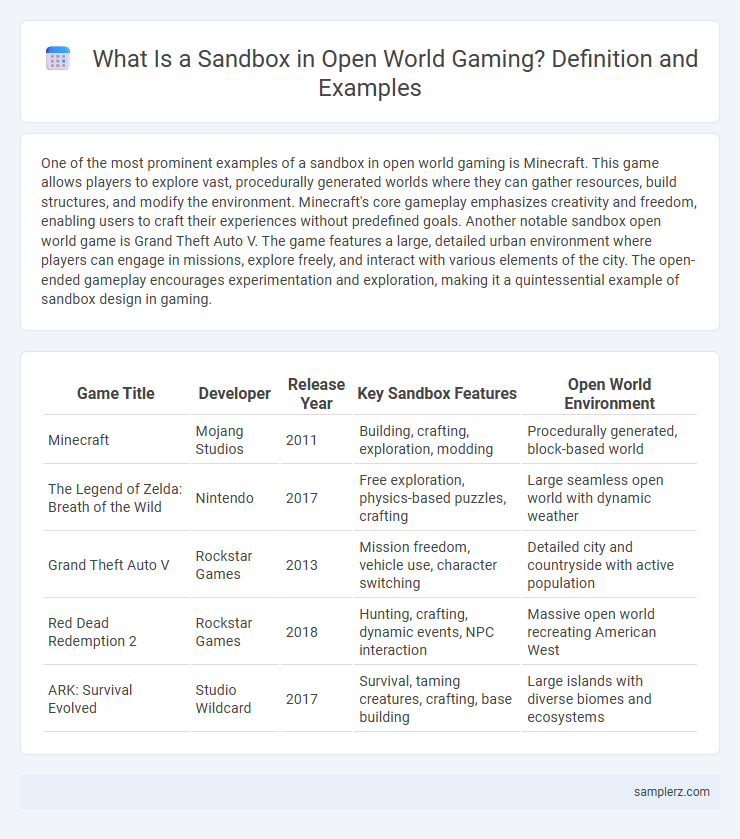One of the most prominent examples of a sandbox in open world gaming is Minecraft. This game allows players to explore vast, procedurally generated worlds where they can gather resources, build structures, and modify the environment. Minecraft's core gameplay emphasizes creativity and freedom, enabling users to craft their experiences without predefined goals. Another notable sandbox open world game is Grand Theft Auto V. The game features a large, detailed urban environment where players can engage in missions, explore freely, and interact with various elements of the city. The open-ended gameplay encourages experimentation and exploration, making it a quintessential example of sandbox design in gaming.
Table of Comparison
| Game Title | Developer | Release Year | Key Sandbox Features | Open World Environment |
|---|---|---|---|---|
| Minecraft | Mojang Studios | 2011 | Building, crafting, exploration, modding | Procedurally generated, block-based world |
| The Legend of Zelda: Breath of the Wild | Nintendo | 2017 | Free exploration, physics-based puzzles, crafting | Large seamless open world with dynamic weather |
| Grand Theft Auto V | Rockstar Games | 2013 | Mission freedom, vehicle use, character switching | Detailed city and countryside with active population |
| Red Dead Redemption 2 | Rockstar Games | 2018 | Hunting, crafting, dynamic events, NPC interaction | Massive open world recreating American West |
| ARK: Survival Evolved | Studio Wildcard | 2017 | Survival, taming creatures, crafting, base building | Large islands with diverse biomes and ecosystems |
Defining Sandbox Elements in Open-World Games
Sandbox elements in open-world games include player freedom, interactive environments, and emergent gameplay opportunities. Titles like Minecraft showcase a fully manipulable world where players build and alter terrain, while Grand Theft Auto V offers dynamic NPC interactions and multiple mission paths. These components create immersive experiences by enabling exploration, creativity, and non-linear progression.
Iconic Sandbox Features in Popular Titles
Iconic sandbox features in popular open world games include Minecraft's limitless terrain manipulation and resource gathering, Grand Theft Auto V's seamless city exploration with dynamic NPC interactions, and The Legend of Zelda: Breath of the Wild's intricate physics-based puzzles and environmental interactivity. These titles showcase player freedom through crafting, building, and nonlinear quest progression, setting benchmarks for immersive gameplay. Their vast, reactive worlds emphasize creativity and exploration, defining the sandbox genre in contemporary gaming.
Player Freedom: Exploring Nonlinear Gameplay
Sandbox games such as "Minecraft" and "The Legend of Zelda: Breath of the Wild" exemplify player freedom by offering vast open worlds where nonlinear gameplay thrives. Players can choose their own paths, engage in diverse activities, and experiment with the environment, enabling unique experiences beyond scripted missions. This design emphasizes creativity and exploration, making player choice central to game progression.
Dynamic World Interaction and Creativity
Sandbox games like Minecraft exemplify dynamic world interaction and creativity by enabling players to manipulate terrain, build structures, and craft items in an open world. The game's physics engine and resource system allow real-time environmental changes and diverse player-driven modifications. This freedom fosters unique storytelling and problem-solving experiences, emphasizing player agency within a constantly evolving virtual space.
Crafting Systems as Core Sandbox Mechanics
Sandbox games like Minecraft exemplify open-world environments where crafting systems drive core gameplay. Players gather raw materials such as wood, stone, and metal to create tools, weapons, and structures, enabling extensive customization and exploration. This crafting mechanic fosters player creativity and emergent gameplay, making resource management and item synthesis fundamental to the sandbox experience.
Emergent Gameplay: Unscripted Player Experiences
Sandbox games like Minecraft exemplify emergent gameplay by allowing players to create complex structures and modify the environment without predefined goals. In open-world titles such as The Legend of Zelda: Breath of the Wild, players interact with dynamic systems, resulting in spontaneous scenarios driven by physics and AI interactions. These unscripted experiences highlight the freedom and creativity intrinsic to sandbox design, fostering unique player-driven narratives.
Modding Communities Expanding Sandbox Worlds
Modding communities significantly expand sandbox worlds in open-world games like Minecraft and Skyrim by introducing custom content, new gameplay mechanics, and enhanced graphics. These user-generated modifications extend the longevity and replayability of the base game, fostering vibrant ecosystems where players continuously innovate and share creations. This active modding culture transforms sandbox environments into dynamic, evolving platforms that encourage creativity and personalized experiences.
Role of AI in Shaping Living Game Environments
In open-world sandbox games like "Minecraft" and "The Elder Scrolls V: Skyrim," AI drives dynamic interactions, enabling NPCs to adapt realistically to player actions and environmental changes. Advanced procedural generation algorithms create diverse ecosystems and evolving weather systems, enhancing immersion and unpredictability. This integration of AI fosters a living game environment where player choices influence narrative outcomes and world behavior in meaningful ways.
Comparing Sandbox Worlds Across Game Franchises
Sandbox worlds in gaming franchises like Grand Theft Auto, Minecraft, and The Legend of Zelda: Breath of the Wild exemplify diverse approaches to open-world design, offering varied levels of player freedom and environmental interaction. Grand Theft Auto emphasizes urban realism and narrative-driven chaos, Minecraft centers on creative construction within a block-based world, while Breath of the Wild combines exploration with intricate physics and survival mechanics. Analyzing these franchises reveals distinct sandbox philosophies that shape player engagement, from structured missions to emergent gameplay and expansive crafting systems.
Future Trends in Open-World Sandbox Design
Emerging trends in open-world sandbox games emphasize dynamic ecosystems and AI-driven NPC behaviors to create immersive, responsive environments. Procedural generation and modular world-building enable expansive, unique gameplay experiences that evolve based on player interaction and environmental factors. Integration of cloud computing and cross-platform play further enhances scalability and social connectivity in future open-world sandbox design.

example of sandbox in open world Infographic
 samplerz.com
samplerz.com